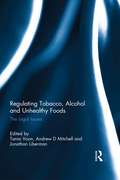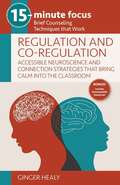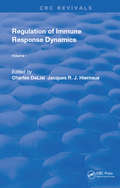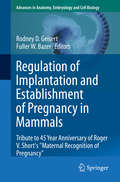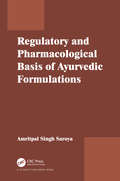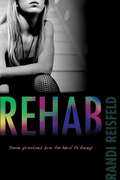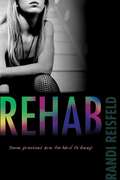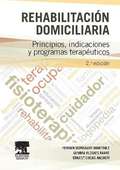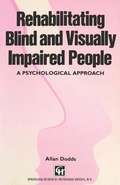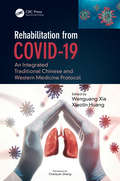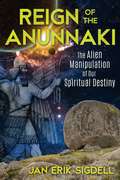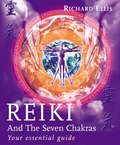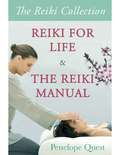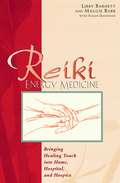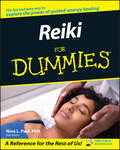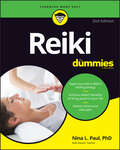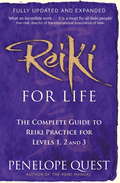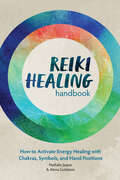- Table View
- List View
Regulating Lifestyle Risks
by Alberto Alemanno Amandine GardeThis collection of essays looks at the role the European Union could and should play in promoting healthier lifestyle, in light of the moral, philosophical, legal and political challenges associated with the regulation of individual choices. By tackling the main non-communicable diseases (NCD) risk factors (tobacco consumption, harmful use of alcohol, unhealthy diets and lack of physical activity), the contributors endeavour to identify common themes and determine whether and, if so, to what extent the lessons learned in relation to each area of EU intervention could be transposed to the others. By focusing on the European Union legal order, the book highlights both the opportunities that legal instruments offer for NCD prevention and control agenda in Europe, as well as the constraints that the law imposes on policy-makers.
Regulating Long-Term Care Quality
by Anna Maresso Vincent Mor Tiziana LeoneThe number of elderly people relying on formal long-term care services is dramatically increasing year after year, and the challenge of ensuring the quality and financial stability of care provision is one faced by governments in both the developed and developing world. This edited book is the first to provide a comprehensive international survey of long-term care provision and regulation, built around a series of case studies from Europe, North America and Asia. The analytical framework allows the different approaches that countries have adopted to be compared side by side and readers are encouraged to consider which quality assurance approaches might best meet their own country's needs. Wider issues underpinning the need to regulate the quality of long-term care are also discussed. This timely book is a valuable resource for policymakers working in the health care sector, researchers and students taking graduate courses on health policy and management.
Regulating Tobacco, Alcohol and Unhealthy Foods: The Legal Issues
by Andrew D. Mitchell Tania Voon Jonathan LibermanThe need to reduce disability and premature deaths from non-communicable diseases (NCDs) is increasingly engaging international organisations and national and sub-national governments. In this book, experts from a range of backgrounds provide insights into the legal implications of regulating tobacco, alcohol and unhealthy foods, all of which are risk factors for NCDs. As individual countries and the international community move to increase targeting of these risk factors, affected industries are turning to national and international law to challenge the resulting regulations. This book explores how the effective regulation of tobacco, alcohol and unhealthy foods can be achieved within the context of international health law, international trade and investment law, international human rights law, international intellectual property law, and domestic laws on constitutional and other matters. Its contributors consider the various tensions that arise in regulating NCD risk factors, as well as offering an original analysis of the relationship between evidence and health regulation. Covering a range of geographical areas, including the Americas, the European Union, Africa and Oceania, the book offers lessons for health and policy practitioners and scholars in navigating the complex legal fields in which the regulation of tobacco, alcohol and unhealthy foods takes place.
Regulation and Co-Regulation: Accessible Neuroscience and Connection Strategies that Bring Calm into the Classroom
by Ginger HealyTackling this critical aspect of learning head-on, 15-Minute Focus: Regulation and Co-Regulation holds out unapologetic hope for healing. As you absorb and apply the wisdom within these pages, get ready: a domino effect will begin when you embrace a new lens of thinking and responding. Everyone in your life - including you - will benefit from the tools you employ to make co-regulation a consistent reality for your students.
Regulation of Immune Response Dynamics: Volume 1 (Routledge Revivals)
by Charles DeLisi Jacques R. J. HiernauxFirst published in 1982: This book has been divided into two volumes; the first focusing primarily on auto-anti-idiotic regulation, and the second primarily on T cell regulation.
Regulation of Implantation and Establishment of Pregnancy in Mammals
by Rodney D. Geisert Fuller W. BazerOver the past few decades technological advances in transcriptomics, proteomics, metabolomics, and glycomics along with the ability to selectively knockout genes of interest has greatly advanced our understanding of maternal-conceptus interactions that are essential for the establishment and maintenance of a successful pregnancy. This knowledge provides a foundation from which to build research endeavors to help resolve infertility, embryonic loss and recurrent abortion in humans, captive wild animals and important farm species. The present volume on "Regulation of Implantation and Establishment of Pregnancy in Mammals" brings together current reviews from leading experts to address the diversity of mechanisms by which species establish and maintain pregnancy. Implantation in rodents, dogs, pigs, cattle, sheep, horses, primates, humans and embryonic diapause in wild species are discussed. Reviews will provide current knowledge on the role of endometrial steroid receptors, adhesion factors, cytokines, interferons, steroids, prostaglandins, growth factors and immune cells involved with regulation of conceptus development.
Regulatory and Pharmacological Basis of Ayurvedic Formulations
by Amritpal SinghRegulatory affairs and pharmacological drug safety issues of Ayurvedic medicine has been overlooked by practitioners for many years. Research in Ayurveda is now a world-wide phenomenon, and several large pharmaceutical corporations are investing money for novel drug discovery from Ayurvedic sources. This book examines the regulatory and pharmacological aspects and includes extensive data on scientific evaluation carried out on Ayurvedic formulations. It will also serve as a reference book on standardization, pre-clinical studies, and clinical and toxicological studies on Ayurvedic formulations.
Rehab
by Randi ReisfeldKenzie Cross never thought she'd vault to insta-fame on the hit TV action drama Spy witness Girls. virtual unknown, she's the show's breakout star -- and the lead in a major new movie.
Rehab
by Randi ReisfeldKenzie Cross never thought she'd vault to insta-fame on the hit TV action drama Spywitness Girls. A virtual unknown, she's the show's breakout star -- and the lead in a major new movie. It's like it's Christmas and her birthday every day, and Kenzie has every reason to let loose and party hard, especially after nonstop press interviews, photo shoots, publicity, and promotion. But when her partying goes a little too far, Kenzie is given an ultimatum by her director: Go to rehab, or get cut from the film. Kenzie agrees to the stint and really kind of enjoys her posh quarters, not to mention her daily swim, her horseback-riding lessons, and her private massages, which are all part of her "therapy." But then it finally hits her why she's really there, and she begins to wonder if she's even ready to leave....
Rehab
by Randi ReisfeldKenzie Cross never thought she'd vault to insta-fame on the hit TV action drama Spywitness Girls. A virtual unknown, she's the show's breakout star -- and the lead in a major new movie. It's like it's Christmas and her birthday every day, and Kenzie has every reason to let loose and party hard, especially after nonstop press interviews, photo shoots, publicity, and promotion. But when her partying goes a little too far, Kenzie is given an ultimatum by her director: Go to rehab, or get cut from the film. Kenzie agrees to the stint and really kind of enjoys her posh quarters, not to mention her daily swim, her horseback-riding lessons, and her private massages, which are all part of her "therapy." But then it finally hits her why she's really there, and she begins to wonder if she's even ready to leave....
Rehabilitación domiciliaria: Principios, indicaciones y programas terapéuticos (Spanish Edition)
by Ferran Montagut Martínez Gemma Flotats Farré Ernest Lucas AndreuNueva edición de una obra original y novedosa que aborda la rehabilitación física de los pacientes desde un nuevo escenario, el domicilio del paciente. <P><P>Aporta a todos los profesionales de la atención domiciliaria y la rehabilitación un enfoque global basado en una perspectiva integral y multidisciplinar justo en un momento en el que la tendencia al Home Care está experimentando un gran crecimiento en todo el mundo. <P><P>Se mantiene la estructura y el planteamiento de la anterior edición, aunque el contenido de algunos capítulos se fusiona para dar lugar a 4 nuevos capítulos. <P><P>Algunos de los nuevos temas tratados en esta edición son la rehabilitación del enfermo crónico a domicilio, la rehabilitación de pacientes con enfermedades raras, la tele-rehabilitación y la evidencia científica en el ámbito de la rehabilitación domiciliaria. Obra escrita por destacados profesionales en la materia con perfiles sanitarios muy distintos, pero todos ellos involucrados en la asistencia domiciliaria del paciente enfermo. <P><P>Dirigida a los profesionales de la rehabilitación en su conjunto: médicos rehabilitadores, fisioterapeutas, terapeutas ocupacionales, así comom a todos los profesionales de la atención domiciliaria. <P><P>Nueva edición actualizada de esta original y novedosa obra que aborda la rehabilitación física de los pacientes desde un nuevo escenario, el domicilio del paciente. <P><P>Obra que acumula 25 años de experiencia de su autor, con más de 300.000 pacientes tratados en su domicilio y aporta a todos los profesionales de la atención domiciliaria y la rehabilitación un enfoque gloal basado en una perspectiva integral y multidisciplinar justo en un momento en el que la tendencia al Home Care está experimentando un gran crecimiento. <P><P>Algunos de los nuevos temas tratados en esta edición son la rehabilitación del enfermo crónico a domicilio, la rehabilitación de pacientes con enfermedades raras, la tele-rehabilitación y la evidencia científica en el ámbito de la rehabilitación domiciliaria.
Rehabilitating Blind and Visually Impaired People: A Psychological Approach
by Allan DoddsDrawing on examples from a range of sensory and physical disabilities, this book emphasizes the importance of treating people individually, based on consideration of their psychological strengths and weaknesses as well as physical functioning. Written for workers with visually impaired people, this book is equally accessible to students and qualified workers, including rehabilitation workers, O & M specialists, occupational therapists, social workers and psychologists. Students and workers should find the language easy to understand and largely non-technical.
Rehabilitation Consultant's Handbook
by Roger O. Weed Timothy F. FieldThe Rehabilitation Consultants Handbook is completely updated with fresh ideas, illustrations and references. A must resource for the present rehabilitation professional, the Handbook covers important topics such as: case preparation, expert work, transferability, labor market access, life care planning, lost earning capacity, and much more. The appendices are loaded with vital references and data that will serve the professional as a primary source of information in future case development. This resource has been revised and updated over the last 18 years and has become a standard reference for private sector rehabilitation.
Rehabilitation Teaching For Persons Experiencing Vision Loss
by Wilma Inkster Linda Newman Diane Storm-Weiss Anne YeadonThis textbook intended for Rehab. Professionals outlines in sequential steps and objectives tasks of daily living and Independent completion of tasks from cooking and kitchen safety, to clothing care, to applying cosmetics.
Rehabilitation from COVID-19: An Integrated Traditional Chinese and Western Medicine Protocol
by Wenguang Xia, Xiaolin Huang and Chanjuan ZhengThe COVID-19 pandemic is unlike anything the world has ever seen before. Its reach is wide, and its effects have been debilitating. Understanding this particular strain of the coronavirus and knowing the best ways to recover are more important than ever. Rehabilitation from COVID-19: An Integrated Traditional Chinese and Western Medicine Protocol contains basic knowledge about COVID-19, including its etiology, pathogenesis, and treatment both in traditional Chinese medicine and Western medicine. It also includes relative assessment and rehabilitation targeting residual dysfunctions due to COVID-19, such as pulmonary dysfunction, mental disorders, and malnutrition, among others. Key Features Presents a new concept of CRN (COVID-19 Rehabilitation Unit) that will protect patients and medical workers Emphasizes special management of rehabilitation procedures under COVID-19 conditions Includes home-based rehabilitation tactics Provides assessment scales to help patients self-evaluate Based on clinical experience from experts, this text has been compiled by those on the frontline against COVID-19 in Wuhan. Rehabilitation from COVID-19 is an informative collection that will be helpful to patients and medical workers alike.
Rehabilitation in Movement Disorders
by Robert Iansek Meg E. MorrisMovement disorders affect a growing patient population, but providing comprehensive care is extremely difficult. Several of these conditions are progressive and incurable; the basal ganglia has a complex role in movement control, with many potential malfunctions. This book focuses on rehabilitation approaches that have been developed and utilized internationally in an attempt to minimize impairment and maximize participation amongst these patients. Each chapter is written by movement disorder experts, rehabilitation specialists and health care professionals, giving a broad overview of current interventions and emphasizing the need for interdisciplinary management, focussing on deliverable outcomes. Common conditions such as Parkinson's disease, cerebral palsy, dystonia and Huntington's disease are comprehensively covered. This book gives neurologists, geriatricians and rehabilitation specialists an up-to-date, theoretically-based approach to managing movement disorders related to basal ganglia malfunction. Also valuable for physiotherapists, occupational therapists, speech pathologists, nurses and social workers seeking to develop and plan appropriate interventions.
Reichel's Care of the Elderly: Clinical Aspects of Aging (6th Edition)
by William Reichel Christine Arenson Jan Busby-Whitehead Kenneth Brummel-Smith James G. O'Brien Mary H. PalmerThe sixth edition of Reichel's Care of the Elderly: Clinical Aspects of Aging remains the pioneering text for the practicing physician confronted with the unique problems of an increasingly elderly population. Dr. William Reichel's formative text is designed as a practical and useful guide for all levels of geriatric care, from medical students to geriatric specialists. This book emphasizes clinical management and addressed problems from the simple to the highly complex. The renowned editors have revised every chapter and have included the most recent advances in elderly care. New chapters include hormonal therapy in post-menopausal women, drug therapy for Alzheimer's sufferers, alternative medicine, the chronic understaffing of nursing homes, management of delirium, and ethical issues. Comprehensive and written for any clinicians caring for older patients (including family physicians, general internists, nurse practitioners, geriatricians, and other specialists), this esteemed text provides practical and trusted advice.
Reign of the Anunnaki: The Alien Manipulation of Our Spiritual Destiny
by Jan Erik SigdellReveals the ongoing alien manipulation of humanity and how we can break free • Explores how the Anunnaki have maintained invisible surveillance over us and how they control our development through religion, secret societies, and catastrophes • Reveals how they feed off our energies and how this ability has allowed them to remain here on Earth as multidimensional entities, enforcing their control invisibly • Explains how they established religion to control us and how Gnostic Christianity--which came from Christ and not the Anunnaki--offers a way out of their matrix of control Cuneiform texts found on clay plates in Mesopotamia tell us about an extraterrestrial race, called the Anunnaki, who came from space to exploit our planet. Through genetic manipulation, they created modern humans from existing earthly life forms to serve them as slaves. They physically left our planet millennia ago, but as Jan Erik Sigdell reveals, their influence and control over humanity is still pervasive and significant. Sigdell explains how the Anunnaki have maintained invisible surveillance over us as well as control over how humanity develops, setting limits on our evolution and holding back our development by means of manipulation and catastrophes, including the deluge immortalized in the Bible and many other ancient myths. He shows how they still manipulate our politics and affairs via secret societies, such as the Illuminati, and the political elite, such as the Bilderberg Group. Examining ancient descriptions of the Anunnaki as entities that resemble winged reptiles or amphibians, the author also explores their diet and how they feed off blood and the energies given off by lower life forms, such as humans, when they are expressing extreme negative emotions, having sex, or dying. This energy-feeding ability has allowed them to remain here on Earth as multidimensional entities, enforcing their control invisibly. He explains how the Anunnaki established religions as tools for control, setting up the major religions with themselves as “gods” and playing them against each other to keep humanity’s attention away from ongoing Anunnaki manipulation. They have also hidden from us the existence of the true highest creator, who created the cosmos as well as the Anunnaki themselves. The author reveals how the highest creator sent a messenger called Jesus to expose the Anunnaki and show us a way out of their matrix of control through a spirituality based on love, empathy, and sacred sexuality. But the “god” of the Anunnaki defeated this messenger and replaced him with a false Christ. This led to the development of Paulinian Christianity under Anunnaki influence, as well as other parallel religions such as Islam, and the suppression and elimination of the original Christianity, Gnostic Christianity. With the discovery of hidden Gnostic texts and teachings at Nag Hammadi in 1945, the way is now paved for our release from the reign of the Anunnaki.
Reiki And The Seven Chakras: Your Essential Guide to the First Level
by Richard EllisReiki is a unique system of healing that allows you to harness and transmit energy through your hands, restoring balance and harmony within the body and bringing relief to a wide range of physical and emotional problems. This book, by renowned Reiki teacher Richard Ellis, illustrates all the hand positions used for the first level of Reiki, but it goes much further and shows them in their relation to the seven chakras. Chakras are the main energy points of the body and provide the anatomy of energy healing. These are different for everyone, and so to practise Reiki effectively you need to understand a person's chakras, which will in turn explain the type of person they are and the health problems they are vulnerable to. For example, one person may have an excessive first chakra, making them prone to obesity or digestive problems, and to pessimism, while another may be deficient, making them vulnerable to anorexia and restlessness. You would therefore approach these two people differently. Reiki and the Seven Chakras captures the feeling of wonder that surrounds Reiki, but it is also an immensely practical guide. So many of the current books on Reiki are very dry, following a formula of detailing the history of Reiki healing and then showing you how to do it. This one breaks the mould and is written from a very personal point of view, which makes it incredibly interesting to read and also very accessible – essential if you are to understand the true nature and potential of Reiki.
Reiki Collection
by Penelope Quest Kathy RobertsGet these two books on the increasingly popular Reiki healing technique--an over $35 value for only $23.99! Penelope Quest is one the most respected and sought-after teachers and practitioners of Reiki, a powerful energy-healing technique. Now, readers can enjoy and learn from her seminal works--Reiki for Life and The Reiki Manual--at a special introductory price! Reiki for Life An exciting and comprehensive handbook, Reiki for Life contains everything readers need to know about the healing art of Reiki. This practical guide covers all points: basic routines, details about the power and potential of each level, special techniques for enhancing Reiki practice, and helpful direction on the use of Reiki toward spiritual growth. Penelope Quest also compares the origins and development of Reiki in the West and the East, revealing methods specific to the original Japanese Reiki tradition. Suitable for beginners, experienced practitioners, and teachers alike, this book: *explains what Reiki is and how it works; *gives detailed instruction in First and Second Degree techniques; *illustrates how to perform Reiki on yourself, as well as others; *advises on how to become a Reiki Master/teacher; and *includes special advanced methods for working with Reiki. Complete with illustrations and a useful section of resources, Reiki for Life is a must-have for the tens of thousands of Western seekers anxious to learn about this fast-growing healing practice. The Reiki Manual Reiki is a holistic system for balancing, healing, and harmonizing all aspects of the person-body, mind, emotions, and spirit-encouraging deep relaxation and the release of stress and tension, and promoting awareness and spiritual growth. This comprehensive manual provides much-needed support for students and teachers who want to follow the best practices. Covering Reiki levels 1, 2, and 3, this book conveys information in an accessible, structured, and interactive way to enhance the reader's understanding, knowledge, and experience of the practice. The final section of the manual contains reference material specifically for students who wish to become professional practitioners, and for Masters who want to broaden their training. This section also offers the foundation for additional courses or workshops on topics such as health and safety and managing a successful practice. The Reiki Manual can be used: *as student preparation before a Reiki class *as a textbook during Reiki courses *as post-course reading, or for reviewing what has already been learned (it includes revision questions and revision activities) *by Reiki practitioners to help them practice in the best, most professional way and by Reiki Masters as a guide to devise and deliver a Reiki course. More extensive than any other Reiki book on the market, The Reiki Manual will be referred to by lay readers as well as devoted students for many years to come!
Reiki Energy Medicine: Bringing Healing Touch into Home, Hospital, and Hospice
by Libby Barnett Maggie Babb Susan DavidsonReiki is an ancient, hands-on healing art with origins in the Tibetan sutras. It has been used primarily by individuals in a daily practice that helps recharge, realign, and rebalance energy in the body. Today Reiki is joining other complementary therapies in the conventional settings of hospitals, hospices, counseling centers, emergency rooms, intensive care units. Nurses, physical therapists, surgeons, midwives, and anesthetists report that Reiki can help manage pain and promote healing. Counselors and caregivers treating those with terminal illness find that Reiki gives patients an increased physical, emotional, and psychological ability to cope. Reiki Energy Medicine explains the body's energy system, and describes how Reiki can be used in a variety of settings to balance energy and create the conditions needed for healing. Reiki Energy Medicine is the first book to show how this ancient art of touch therapy can work within our mainstream health care system. As our health-care system challenges institutions to offer high-quality but cost-effective service, Reiki can be an important tool that can help maximize patient care and minimize recovery time. Reiki does not require complicated techniques or extensive training: practitioners of many disciplines are able to easily incorporate it into their specialties.
Reiki For Dummies
by Nina L. PaulMillions of people seek ways to relax, promote healing, or connect with their soul. Reiki (pronounced ray-key) is a simple but profound healing system that was originally developed in Japan. Reiki means "spiritual energy" or "universal life-force energy." The Reiki system is universal because it can be used by people of any background or religion. Reiki For Dummies explains how you can harness this energy for yourself. Reiki For Dummies is a plain-English Reiki guidebook. Discover what Reiki is, where it came from, and how to: Find and get the most from a Reiki treatment Use Reiki to boost your physical and emotional health Locate a Reiki class and become a Reiki practitioner Reiki For Dummies is amply illustrated and full of useful information on: Reiki symbols (plus nontraditional symbols) Reiki hand positions (for giving Reiki to yourself or others) Reiki for pets and animals Reiki for children and adults Reiki and surgery or medicines Reiki at birth or end-of-life Reiki in the house, in the car, or at work When you're ready to go further, Reiki For Dummies covers: Western and Japanese Reiki techniques; crystals, long distance Reiki, and setting up a successful Reiki practice. Reiki For Dummies is for you whether you are just finding out about Reiki or you are a seasoned professional who is looking for a clearly written, up-to-date, inclusive, and comprehensive source of Reiki information. Nina Paul, PhD (New York, NY), is a Reiki Master who uses Reiki to help herself and others. She has a doctorate in immunology and epidemiology and she believes in a holistic approach to health and wellness . Nina is also the author of the compassionate guide: Living with Hepatitis C For Dummies (0-7645-7620-8).
Reiki For Dummies
by Nina L. PaulReiki—the alternative medicine therapy that's becoming mainstream Reiki is a subtle, non-invasive form of healing that uses spiritually guided life force energy, and 60% of top hospitals in the United States now offer it as complementary treatment for anxiety, depression, pain relief, and more. Reiki For Dummies is a clear and easy-to-follow guide to the origins of Reiki, where you can study Reiki, what it can do for you, what to expect in a session, and how to use Reiki at home. This book takes you through the principles, practice, and uses of Reiki—even if you're skeptical or taking your first Reiki class. Dummies is the perfect starting point for anyone interested in benefiting from Reiki or becoming a Reiki healer. Discover how Reiki fits in with other healing practices, and how it just might transform your life. This book makes it easy. Learn what Reiki is and how to find a Reiki practitioner Prepare for your Reiki session and set realistic goals and expectations Explore Reiki classes, symbols, and techniques Get started performing Reiki with basic hand positions and self-treatment Discover the fascinating history and evolution of this Japanese healing practice This edition has been expanded with new information on self-Reiki, mind-body healing with Reiki, and becoming a Reiki professional. Plus, you'll find the latest Reiki resources to expand your healing journey.
Reiki For Life: The complete guide to reiki practice for levels 1, 2 & 3
by Penelope QuestReiki for Life is the definitive guide to the practice of Reiki techniques for both the beginner and the more experienced Reiki practitioner. Penelope Quest, a leading expert with a wealth of experience as a Reiki Master and former Vice-Chairman and Education Co-ordinator for the UK Reiki Federation, tells you everything you need to know. Whether you want to recap on the basic Reiki routines, follow detailed instruction on First and Second Degree techniques, discover how to use Reiki for spiritual growth or find out how to become a Reiki Master, this is the book for you.This classic text, used by teacher and student alike, has now been fully updated and expanded to include even more illustrations to help guide you through each level of Reiki plus the very latest on developments in Reiki training in the West, how the mind-body connection works, the Japanese tradition of Reiki and the legal requirements for Reiki practitioners.
Reiki Healing Handbook: How to Activate Energy Healing with Chakras, Symbols, and Hand Positions
by Nathalie Jaspar Alena GoldsteinBalance your mind and body—unlock the power of Reiki Whether you're looking to relieve stress, practice more gratitude, or boost general well-being, the Reiki Healing Handbook can help. Reiki is a Japanese healing practice that restores the flow of energy between your body, mind, and spirit. This Reiki reference book will show you how to align your chakras (energy centers) and incorporate symbols and hand positions into a balanced routine. You'll learn how to clear your mind and focus your energy where it's needed so you can reduce negative thoughts and feelings, and start healing. Reiki Healing Handbook includes: The 5 precepts—Learn about the five core principles of Reiki: Just for today: do not anger, do not worry, be grateful, practice diligently, and show compassion. Guided techniques—Beautiful illustrations show you the proper way to perform the hand positions and engage different chakras. Mix and match—Find tips for adding crystals, yoga, essential oils, and other tools to your practice for stronger energy flow. Improve your energy flow and start healing with Reiki.

